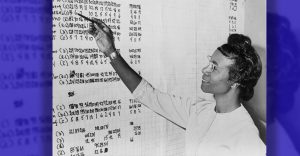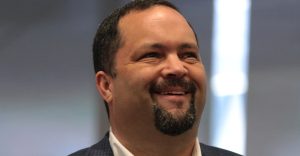National
Fraternity in Racist Video Has Roots in Antebellum South

A sign post is seen outside the international headquarters of Sigma Alpha Epsilon in Evanston, Illinois on March 10, 2015. Sigma Alpha Epsilon’s international headquarters may be in Illinois, but the fraternity’s roots are firmly planted in the antebellum South. (AP Photo/Teresa Crawford)
ALLEN G. BREED, AP National Writer
Sigma Alpha Epsilon was born a few years before the Civil War in the antebellum South, the creation of a small group that set out to forge bonds among young men that would “hold them together for all time.”
The fraternity founded at the University of Alabama held its Southern heritage close. “We came up from Dixie land,” says a ditty from an old SAE songbook.
But nearly 160 years later, another song — this one chanted by members of the frat’s University of Oklahoma chapter and containing racial slurs and lynching references — hearkens back to the land of cotton and puts a new spotlight on the group’s history.
SAE officials insist the chant that resulted in suspension of the chapter is neither a sanctioned song nor is it taught to fraternity members.
If there are any other chapters that use the song, “we need to address that with those chapters and stop it immediately to stamp out this type of behavior,” SAE spokesman Brandon Weghorst said.
The lyrics “are so hateful and spiteful that it’s embarrassing to think that Sigma Alpha Epsilon members would even know the chant or how it goes, if they’ve heard it.”
The fraternity was also investigating reports of other SAE incidents that may have been tainted with racism, Weghorst said.
SAE began on the Tuscaloosa campus on March 9, 1856, a few months after Noble Leslie DeVotie outlined his vision to a close circle of friends during a stroll along the banks of the Black Warrior River.
The founders envisioned the members sharing a lifelong bond, according to a 1916 history of the fraternity by William C. Levere.
“So it came about that in the late hours of a stormy night, the friends met in the old southern mansion and by the flicker of dripping candles organized Sigma Alpha Epsilon,” Levere wrote.
More chapters were soon launched in Tennessee, North Carolina and Washington, D.C., at what is now George Washington University. But the founders were not interested in a national presence.
According to Levere, it was their intention “to confine the fraternity to the southern states.”
When a North Carolina chapter member raised the topic of a “Northern Extension,” charter member Thomas Chappell Cook — who later served as a surgeon in the Confederate army — responded that “the constant agitation of the slavery question was a barrier to northern chapters, as it would preclude the possibility of harmony.”
The Civil War soon put an end to the internal debate.
Because of the fighting, the fraternity’s charter was surrendered in 1861. The Washington City Rho chapter was the only one to emerge from the war intact. SAE would not return to its birthplace until 1886, after the Reconstruction-era ban on “secret societies” was relaxed and the school’s trustees, in Levere’s words, repealed “obnoxious anti-fraternity laws.”
In the meantime, the fraternity had granted its first Northern charter in 1883 to, of all schools, Pennsylvania College — the abolitionist institution now known as Gettysburg College.
The editors of the New Encyclopedia of Southern Culture call SAE “the first Greek-letter society founded in Dixie to take permanent root.”
In December 1930, the fraternity dedicated its international headquarters in the Chicago suburb of Evanston. But, like other fraternities North and South, SAE had not yet embraced racial diversity.
In his 2013 book, “The People’s Advocate,” attorney Daniel P. Sheehan claims credit for championing the bid of Tommy Williamson, who he wrote was the first black man to receive a nomination for membership in SAE.
Sheehan, who said he was social chairman of SAE’s Harvard chapter in 1966, said Williamson’s was the first name he called when it was time to vote for new members.
He and Williamson, a defensive lineman on the Crimson football team, both lived at Kirkland House.
On the first ballot, Sheehan said, Williamson received three “blackballs,” or negative votes.
Sheehan then announced he would blackball every other nominee until whoever had blocked Williamson “fessed up and gave us their reasons,” he wrote. It took six more ballots for a member to admit that he was voting against Williamson because he’d heard that the Piedmont, California, native dated white women.
Sheehan said Williamson’s nomination was approved on the seventh ballot. But when Sheehan told him how the vote had gone down, he wrote, Williamson declined the invitation.
Reached by telephone Tuesday, Williamson, who practices employment law in Washington, D.C., told The Associated Press that he wasn’t really interested in joining a fraternity, especially if some members didn’t want him.
“I didn’t want to be the sort of obsessive token negro,” he said.
Weghorst was unable to say whether Williamson was indeed the first black man formally invited to join a chapter because only within the last couple of years has the organization started to track the ethnicity of people who join, he said.
SAE has had its share of controversy in more recent years.
— In 1988, the founding chapter was suspended for violations of the university’s drug codes. The suspension was lifted two years later, only to be levied again in 1992 when the chapter failed to meet the goals outlined for reinstatement.
Most of the actions taken against SAE in the past have been for infractions of a non-racial nature. But the University of Oklahoma video is not an isolated incident.
— In October 2006, the University of Memphis chapter was investigated after a freshman member complained that his brothers made inappropriate remarks to and about his black girlfriend. Two members were later suspended.
— In February 2013, Washington University in St. Louis suspended its SAE chapter while investigating claims that pledges engaged in racially offensive behavior toward minorities.
— In December 2014, Clemson University suspended the frat after a gang-themed “Cripmas party” at which white members dressed in T-shirts bearing images of handcuffs and the late rapper Tupac Shakur.
Last year, SAE reached what it called “a historic milestone” — becoming the first large national fraternity to eliminate the pledge process.
“Instead, we have implemented a holistic education known as the True Gentleman Experience,” SAE says on its website. “It provides education throughout a member’s collegiate tenure and fosters both personal and professional development.”
___
Associated Press writers Kelly P. Kissel in Little Rock and Teresa Crawford in Chicago also contributed to this story.
___
Allen G. Breed is an AP national writer based in Raleigh, North Carolina. He can be reached at features@ap.org. Follow him on Twitter at https://twitter.com/AllenGBreed.
Copyright 2015 The Associated Press. All rights reserved. This material may not be published, broadcast, rewritten or redistributed.
Alameda County
Seth Curry Makes Impressive Debut with the Golden State Warriors
Seth looked comfortable in his new uniform, seamlessly fitting into the Warriors’ offensive and defensive system. He finished the night with an impressive 14 points, becoming one of the team’s top scorers for the game. Seth’s points came in a variety of ways – floaters, spot-up three-pointers, mid-range jumpers, and a handful of aggressive drives that kept the Oklahoma City Thunder defense on its heels.

By Y’Anad Burrell
Tuesday night was anything but ordinary for fans in San Francisco as Seth Curry made his highly anticipated debut as a new member of the Golden State Warriors. Seth didn’t disappoint, delivering a performance that not only showcased his scoring ability but also demonstrated his added value to the team.
At 35, the 12-year NBA veteran on Monday signed a contract to play with the Warriors for the rest of the season.
Seth looked comfortable in his new uniform, seamlessly fitting into the Warriors’ offensive and defensive system. He finished the night with an impressive 14 points, becoming one of the team’s top scorers for the game. Seth’s points came in a variety of ways – floaters, spot-up three-pointers, mid-range jumpers, and a handful of aggressive drives that kept the Oklahoma City Thunder defense on its heels.
One of the most memorable moments of the evening came before Seth even scored his first points. As he checked into the game, the Chase Center erupted into applause, with fans rising to their feet to give the newest Warrior a standing ovation.
The crowd’s reaction was a testament not only to Seth’s reputation as a sharpshooter but also to the excitement he brings to the Warriors. It was clear that fans quickly embraced Seth as one of their own, eager to see what he could bring to the team’s championship aspirations.
Warriors’ superstar Steph Curry – Seth’s brother – did not play due to an injury. One could only imagine what it would be like if the Curry brothers were on the court together. Magic in the making.
Seth’s debut proved to be a turning point for the Warriors. Not only did he contribute on the scoreboard, but he also brought a sense of confidence and composure to the floor.
While their loss last night, OKC 124 – GSW 112, Seth’s impact was a game-changer and there’s more yet to come. Beyond statistics, it was clear that Seth’s presence elevated the team’s performance, giving the Warriors a new force as they look to make a deep playoff run.
#NNPA BlackPress
LIHEAP Funds Released After Weeks of Delay as States and the District Rush to Protect Households from the Cold
BLACKPRESSUSA NEWSWIRE — The federal government has released $3.6 billion in home heating assistance after a delay that left states preparing for the start of winter without the program’s annual funding.

By Stacy M. Brown
Black Press USA Senior National Correspondent
The federal government has released $3.6 billion in home heating assistance after a delay that left states preparing for the start of winter without the program’s annual funding. The Low-Income Home Energy Assistance Program, known as LIHEAP, helps eligible households pay heating and cooling bills. The release follows a shutdown that stretched 43 days and pushed agencies across the country to warn families of possible disruptions.
State officials in Minnesota, Kansas, New York, and Pennsylvania had already issued alerts that the delay could slow the processing of applications or force families to wait until December for help. In Pennsylvania, more than 300,000 households depend on the program each year. Minnesota officials noted that older adults, young children, and people with disabilities face the highest risk as temperatures fall.
The delay also raised concerns among advocates who track household debt tied to rising utility costs. National Energy Assistance Directors Association Executive Director Mark Wolfe said the funds were “essential and long overdue” and added that high arrearages and increased energy prices have strained families seeking help.
Some states faced additional pressure when other services were affected by the shutdown. According to data reviewed by national energy advocates, roughly 68 percent of LIHEAP households also receive nutrition assistance, and the freeze in multiple programs increased the financial burden on low-income residents. Wolfe said families were placed in “an even more precarious situation than usual” as the shutdown stretched into November.
In Maryland, lawmakers urged the Trump administration to release funds after the state recorded its first cold-related death of the season. The Maryland Department of Health reported that a man in his 30s was found outdoors in Frederick County when temperatures dropped. Last winter, the state documented 75 cold-related deaths, the highest number in five years. Rep Kweisi Mfume joined more than 100 House members calling for immediate federal action and said LIHEAP “is not a luxury” for the 100,000 Maryland households that rely on it. He added that seniors and veterans would be placed at risk if the program remained stalled.
Maryland Gov. Wes Moore used $10.1 million in state funds to keep benefits moving, but noted that states cannot routinely replace federal dollars. His administration said families that rely on medical equipment requiring electricity are particularly vulnerable.
The District of Columbia has already mapped out its FY26 LIHEAP structure in documents filed with the federal government. The District’s plan shows that heating assistance, cooling assistance, weatherization, and year-round crisis assistance operate from October 1 through September 30. The District allocates 50 percent of its LIHEAP funds to heating assistance, 10 percent to cooling, 13 percent to year-round crisis assistance, 15 percent to weatherization, and 10 percent to administrative costs. Two percent is used for services that help residents reduce energy needs, including education on reading utility bills and identifying energy waste.
The District’s plan lists a minimum LIHEAP benefit of $200 and a maximum of $1,800 for both heating and cooling assistance. Crisis benefits are provided separately and may reach up to $500 when needed to resolve an emergency. The plan states that a household is considered in crisis if it has been disconnected from energy service, if heating oil is at 5 percent or less of capacity, or if the household has at least $200 owed after the regular benefit is applied.
The District’s filing notes that LIHEAP staff conduct outreach through community meetings, senior housing sites, Advisory Neighborhood Commissions, social media, posters, and mass mailings. The plan confirms that LIHEAP applicants can apply in person, by mail, by email, or through a mobile-friendly online application and that physically disabled residents may request in-home visits.
As agencies nationwide begin distributing the newly released funds, states continue working through large volumes of applications. Wolfe said LIHEAP administrators “have been notified that the award letters have gone out and the states can begin to draw down the funds.”
#NNPA BlackPress
Seven Steps to Help Your Child Build Meaningful Connections
BLACKPRESSUSA NEWSWIRE — Swinging side by side with a friend on the playground. Sharing chalk over bright, colorful sidewalk drawings. Hiding behind a tree during a spirited game of hide-and-seek. These simple moments between children may seem small, but they matter more than we think

By Niyoka McCoy, Ed.D., Chief Learning Officer, Stride/K12
Swinging side by side with a friend on the playground. Sharing chalk over bright, colorful sidewalk drawings. Hiding behind a tree during a spirited game of hide-and-seek. These simple moments between children may seem small, but they matter more than we think: They lay the foundation for some of life’s most important skills.
Through everyday play, young children begin learning essential social and emotional skills like sharing, resolving conflicts, showing empathy, and managing their emotions. These social skills help shape emotional growth and set kids up for long-term success. Socialization in early childhood isn’t just a “nice-to-have”—it’s essential for development.
Yet today, many young children who haven’t yet started school aren’t getting enough consistent, meaningful interaction with peers. Research shows that there’s a decline in active free play and peer socialization when compared to previous generations.
There are many reasons for this. Children who are home with a parent during the day may spend most of their time with adults, limiting opportunities for peer play. Those in daycare or preschool may have restricted free play, and large classrooms can reduce supervision and social coaching. Some children live in rural areas, are homebound due to illness, have full schedules, or rely on screens to fill their playtime. And for some families, finding other families with young children to connect with isn’t easy.
While these challenges can feel significant, opportunities for connection still exist in every community. Families can take simple steps to help children build friendships, create a sense of belonging, and strengthen social skills. Here are some ideas to get started:
- Storytime sessions at libraries or local bookstores
- Community offerings such as parent-child workshops, art, music, gymnastics, swimming, or sports programs
- Weekly events at children’s museums, which may include art projects, music workshops, or science experiments
- Outdoor exploration, where kids can play with peers
- Local parenting groups that organize playdates and group activities
- Volunteer opportunities where children can participate, such as pet adoption events or packing meals at a food bank
- Classes for kids at local businesses, including hardware, grocery, or craft stores
Some of these community activities are free or low-cost and give kids the chance to build friendships and practice social skills. Parents can also model positive social behavior by interacting with other parents and encouraging their children to play with their peers.
These may seem like small moments of connection, but they can have a powerful impact. Every time your child shares a toy, plays make-believe with peers, or races a friend down the slide, they’re not just playing—they’re learning the skills that build confidence, empathy, and lasting friendships. And it’s good for you, too. Creating intentional opportunities for play also helps you strengthen your own network of parents who can support one another as your children grow together.
-
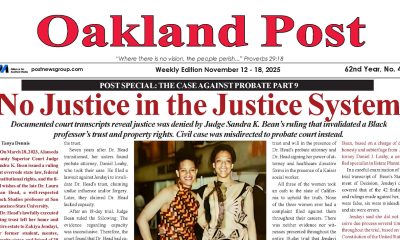
 Activism4 weeks ago
Activism4 weeks agoOakland Post: Week of November 12 – 18, 2025
-
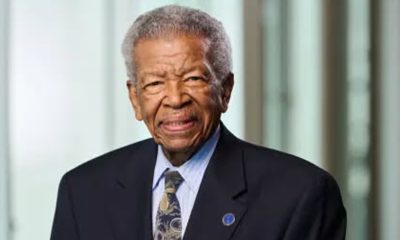
 Activism3 weeks ago
Activism3 weeks agoIN MEMORIAM: William ‘Bill’ Patterson, 94
-

 Activism4 weeks ago
Activism4 weeks agoHow Charles R. Drew University Navigated More Than $20 Million in Fed Cuts – Still Prioritizing Students and Community Health
-

 Bay Area4 weeks ago
Bay Area4 weeks agoNo Justice in the Justice System
-

 #NNPA BlackPress3 weeks ago
#NNPA BlackPress3 weeks agoLewis Hamilton set to start LAST in Saturday Night’s Las Vegas Grand Prix
-

 #NNPA BlackPress3 weeks ago
#NNPA BlackPress3 weeks agoBeyoncé and Jay-Z make rare public appearance with Lewis Hamilton at Las Vegas Grand Prix
-
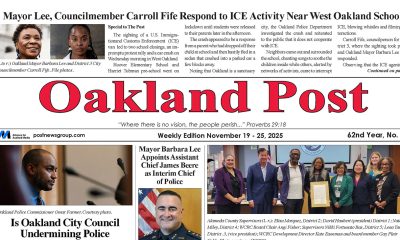
 Activism3 weeks ago
Activism3 weeks agoOakland Post: Week of November 19 – 25, 2025
-

 #NNPA BlackPress4 weeks ago
#NNPA BlackPress4 weeks agoThe Perfumed Hand of Hypocrisy: Trump Hosted Former Terror Suspect While America Condemns a Muslim Mayor

